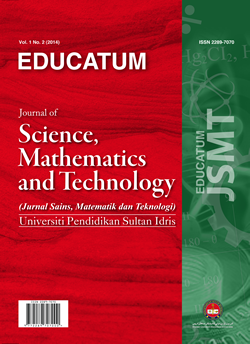Morphological, Structural and Electrical Properties of Coconut Shell-based Reduced Graphene Oxide
DOI:
https://doi.org/10.37134/ejsmt.vol9.1.1.2022Keywords:
Coconut shell, Graphene oxide, reduced graphene oxide, Green reduction, Rose waterAbstract
In this work, reduced graphene oxide (rGO) was produced by green reduction process utilizing rose water as reducing agent. Various reduction temperature were also carried out to investigate its effect to the produced rGO. Prior to the reduction process, GO was initially synthesized by Hummers’ method utilizing coconut shell (CS) as initial carbon source material. The fabricated CS-based GO and rGO were then characterized to investigate their morphological, structural and electrical properties. Based on the measurement, rGO produced by reduction process at room temperature (RT) possessed the best sample among others. rGO_RT showed the highest electrical conductivity (0,08793 ± 0,00174 mS) compared to CS-based GO or other rGO samples.
Downloads
References
Syakir, Norman et al. 2015. Kajian Pembuatan Oksida Grafit Untuk Produksi Oksida Grafena dalam Jumlah Besar. Jurnal Fisika Indonesia. 19(55): 26-29.
Royal Swedish Academy of Sciences. 2010. Graphene: Scientific Background on The Nobel Prize in Physics 2010. Stockholm: The Royal Swedish Academy of Sciences.
Martin, Andrew & Prabir Patra. 2014. Graphene Biosensor for Early Detection of Cancer Utilizing Antigen Concentrations in Saliva. ASEE 2014 Zone I Conference. Bridgeport 3-5 April 2014.
Popescu, Sinziana et al. 2017. Rapid Prototyping of A Low-Cost Graphene-Based Impedimetric Biosensor. Procedia Technology. 27: 274-276.
Liu, Zhuang et al. 2011. Carbon Materials for Drug Delivery and Cancer Therapy. Materials Today. 14: 316-323.
Li, Yong, Jie Yang & J. Song. 2017. Nano Energy System Model and Nanoscale Effect of Graphene Battery in Renewable Energy Electric Vehicle. Renewable and Sustainable Energy Reviews. 69: 652-663.
Lin, Xiao-Feng et al. 2016. Graphene-Based Materials for Polymer Solar Cells. Chinese Chemical Letters. 27(8): 1259-1270.
Yang, Hao et al. 2017. Graphene Supercapacitor with Both High Power and Energy Density. Nanotechnology. 28(44): 1-10.
Franklin, Aaron D. et al. 2012. Double Contacts for Improved Performance of Graphene Transistors. IEEE Electron Device Letters. 33(1): 17-19.
Fregonese, Sebastien et al. 2012. Electrical Compact Modelling of Graphene Transistors. Solid-State Electronics. 73: 27-31.
Azizah, Lita Nur & Diah Susanti. 2014. Pengaruh Variasi Kadar Zn dan Temperatur Hydrotermal Terhadap Struktur dan Nilai Konduktivitas Elektrik Material Graphene. Jurnal Teknik POMITS. 3(2): 209-214.
Hummers, W. S. & R. E. Offeman. 1958. Preparation of Graphitic Oxide. Journal of The American Chemical Society. 80(6): 1339.
Ray, Sekhar C. 2015. Applications of Graphene and Graphene-Oxide Based Nanomaterials. Amsterdam: Elsevier.
Aunkor, M.T.H. et al. 2016. The Green Reduction of Graphene Oxide. RSC Advances. 6(33): 27807-27828.
Kuila, Tapas et al. 2012. A Green Approach for The Reduction of Graphene Oxide by Wild Carrot Root. Carbon. 50: 914-921.
Upadhyay, Ravi Kant et al. 2015. Grape Extract Assisted Green Synthesis of Reduced Graphene Oxide for Water Treatment Application. Materials Letters. 160: 355-358.
Suresh D. et al. 2015. Spinach Assisted Green Reduction of Graphene Oxide and Its Antioxidant and Dye Absorption Properties. Ceramics International. 41(3): 4810-4813.
Haghighi, Behzad & M. A. Tabrizi. 2013. Green-Synthesis of Reduced Graphene Oxide Nanosheets Using Rose Water and A Survey on Their Characteristics and Applications. RSC Advances. 3(32): 13365-13371.
Astuti, Nur Fitri Dwi. 2017. Pengaruh Variasi Massa Karbon Sekam Padi Terhadap Sintesis Material Graphene Oxide dengan Metode Liquid Phase Exfoliation Menggunakan Blender, Sonifikasi, dan Blender+Sonifikasi Berdasarkan Uji UV-Vis. Skripsi. Yogyakarta: Fakultas Matematika dan Ilmu Pengetahuan Alam Universitas Negeri Yogyakarta.
Wang, Jie et al. 2012. Rod-Coating: Towards Large-Area Fabrication of Uniform Reduced Graphene Oxide Films for Flexible Touch Screens. Advanced Materials. 24(21): 2874-2878.
Wahyuni, Linda & Zefania Setyani. 2017. Sintesis Komposit Karbon Aktif-Graphene dari Kulit Salak dengan Metode Simultan Grafitisasi Aktivasi-KOH. Skripsi. Bandung: Fakultas Teknologi Industri Universitas Katolik Parahyangan.
Wachid, Frischa M. et al. 2014. Synthesis and Characterization of Nanocrystalline Graphite from Coconut Shell with Heating Process. AIP Conference Proceedings. 1586: 202-206.
Kumila, Biaunik Niski. 2015. Methanol Sensing of Reduced Graphene Oxide with Various Degrees of Reduction. Tesis. Tainan: Department of Materials Science and Engineering National Cheng Kung University.
Kurniawan, Arie Fauzi. 2016. Sintesis Komposit Grafena Oksida Tereduksi (rGO) Hasil Pembakaran Tempurung Kelapa Tua dengan Seng Oksida (ZnO) Sebagai Superkapasitor. Skripsi. Surabaya: Fakultas Matematika dan Ilmu Pengetahuan Alam Institut Teknologi Sepuluh Nopember.





